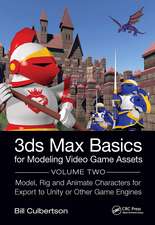Isosurfaces: Geometry, Topology, and Algorithms
Autor Rephael Wengeren Limba Engleză Hardback – 24 iun 2013
In color throughout, the book covers the Marching Cubes algorithm and variants, dual contouring algorithms, multilinear interpolation, multiresolution isosurface extraction, isosurfaces in four dimensions, interval volumes, and contour trees. It also describes data structures for faster isosurface extraction as well as methods for selecting significant isovalues.
For designers of visualization software, the book presents an organized overview of the various algorithms associated with isosurfaces. For graduate students, it provides a solid introduction to research in this area. For visualization researchers, the book serves as a reference to the vast literature on isosurfaces.
Preț: 770.50 lei
Preț vechi: 846.70 lei
-9% Nou
Puncte Express: 1156
Preț estimativ în valută:
147.45€ • 160.11$ • 123.86£
147.45€ • 160.11$ • 123.86£
Carte disponibilă
Livrare economică 01-15 aprilie
Livrare express 15-21 martie pentru 56.12 lei
Preluare comenzi: 021 569.72.76
Specificații
ISBN-13: 9781466570979
ISBN-10: 1466570970
Pagini: 488
Ilustrații: 228 b/w images, 228 color images and over 100
Dimensiuni: 191 x 235 x 30 mm
Greutate: 1.18 kg
Ediția:New.
Editura: CRC Press
Colecția A K Peters/CRC Press
ISBN-10: 1466570970
Pagini: 488
Ilustrații: 228 b/w images, 228 color images and over 100
Dimensiuni: 191 x 235 x 30 mm
Greutate: 1.18 kg
Ediția:New.
Editura: CRC Press
Colecția A K Peters/CRC Press
Public țintă
Visualization researchers, software designers, and graduate and advanced undergraduate students in computer graphics.Cuprins
Introduction. Marching Cubes and Variants. Dual Contouring. Multilinear Interpolation. Isosurface Patch Construction. Isosurface Generation in 4D. Interval Volumes. Data Structures. Multiresolution Tetrahedral Meshes. Multiresolution Polyhedral Meshes. Isovalues. Contour Trees. Appendices. Bibliography. Index.
Recenzii
"Visualization has long needed a solid, standard and detailed text on the algorithmic aspects of isosurface construction and use. This text will become the standard entry point into this vast literature for at least the next decade, even for researchers already accustomed to working with isosurfaces. It belongs on every professional’s shelf."
—Hamish Carr, University of Leeds
"Isosurfaces are one of the most prevalent ways to visualize three-dimensional data. This wonderful book is the first that nicely summarizes the foundations as well as the state of the art on isosurfaces. Everyone, from the novice to the expert, will find something new and interesting in this book. This book's treatment of isosurfaces goes way beyond the surface, deep into the heart and soul of this rich topic situated in between the fields of graphics, visualization, and computational geometry."
—Torsten Möller, University of Vienna (Universität Wien)
"…well written, well illustrated, and extensively referenced."
—Lyuba S. Alboul, Mathematical Reviews Clippings, January 2015
—Hamish Carr, University of Leeds
"Isosurfaces are one of the most prevalent ways to visualize three-dimensional data. This wonderful book is the first that nicely summarizes the foundations as well as the state of the art on isosurfaces. Everyone, from the novice to the expert, will find something new and interesting in this book. This book's treatment of isosurfaces goes way beyond the surface, deep into the heart and soul of this rich topic situated in between the fields of graphics, visualization, and computational geometry."
—Torsten Möller, University of Vienna (Universität Wien)
"…well written, well illustrated, and extensively referenced."
—Lyuba S. Alboul, Mathematical Reviews Clippings, January 2015
Notă biografică
Rephael Wenger is an associate professor in the Department of Computer Science and Engineering at the Ohio State University. He earned a Ph.D. from McGill University. He has published over fifty papers in computational geometry, computational topology, combinatorics, geometric modeling, and visualization.
Descriere
This work represents the first book to focus on basic algorithms for isosurface construction. It also gives a rigorous mathematical perspective on some of the algorithms and results. In color throughout, the book covers the Marching Cubes algorithm and variants, dual contouring algorithms, multilinear interpolation, multiresolution isosurface extraction, isosurfaces in four dimensions, interval volumes, and contour trees. It also describes data structures for faster isosurface extraction as well as methods for selecting significant isovalues.

























